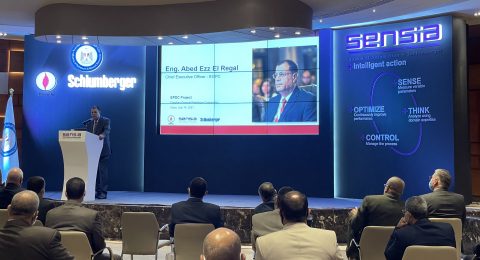Shale Gas Production
Recent technological advances have allowed for economically viable extraction of unconventional forms of gas. Unconventional forms of natural gas including shale, tight gas, and coalbed methane, generally occur in lower concentrations over larger areas compared to conventional gas reservoirs, making it difficult to extract. Currently, shale gas production is predominately limited to the United States, where it continues to grow rapidly. Shale gas was primarily responsible for the increase in gas production in the United States between 2010-2011. Noting the success of shale in the US, many other countries, including Egypt, are now considering the possibilities of tapping their own unconventional resources.
Technological advances in drilling have allowed for the economically viable production of shale gas. In order to access shale gas reservoirs, producers generally utilize horizontal drilling, as well as, slick-water hydraulic fracturing. Horizontal wells are constructed so that wells have as much contact as possible with the shale matrix, while at the same time limiting surface disturbance. The vertical section of wells may reach hundreds to thousands of feet below the surface and horizontal sections can extend 1,000 to 6,000 feet.
Hydraulic fracturing, commonly referred to as fracking, is the process of injecting highly pressurized fracturing fluids into wells. Fracturing fluids generally consist of water, a proppant (often sand), and chemicals. The pressurized fluids stimulate the reservoir by creating fissures in the shale. The proppant particles then hold these fractures open, allowing for the release and flow of natural gas. Slick-water refers to the chemical additives in the fracturing fluid that allow for faster pumping of fluids into wells and produces a higher-pressure shale fracture.
Environmental Impacts
As shale gas production continues to grow its environmental impacts have drawn both praise and criticism. Due to hydraulic fracturing’s high water usage, concerns have been raised over water scarcity. In the US, water scarcity does not present a serious threat at the national level, as water consumption by shale gas production is lower than that of other fossil fuels. According to a report by Erik Mielke, Laura Diaz Anadon and Venkatech Narayanamurti of Harvard’s Belfer Center, water consumption for shale gas production ranges from 0.6 to 1.8 gal/MMBtu. The report states that increased production of shale gas in the US may reduce water consumption by the energy sector as a whole.
Despite consuming less water than other fossil fuels, water consumption during hydraulic fracturing for shale gas can be problematic at the local level. Shale gas production generally accounts for less than 2% of a state’s water consumption; however, at the local level in drilling areas it is often significantly more. According to a recent report by CERES, 47% of shale gas and tight oil wells are in regions with high to extremely high water stress, meaning that over 80% of the water available annually is being consumed within the region. Increased water consumption in areas with extremely high water stress may create tensions between gas companies and agricultural producers over water resources.
Shale producers are actively seeking solutions to limit their freshwater consumption. Alternatives including saline water, wastewater, seawater, and recycled water are being explored. Advances have been made in places like Eagle Ford, Texas where saline water is being utilized for approximately 20% and the Marcellus region in Pennsylvania which has achieved a 40% recycling rate of fracturing fluids. Recycling refers to the reuse of recovered fracturing fluids, known as flowback fluids. However, recycling has its limits, as 20% to 80% of fracturing fluids remain in the ground, unable to be recycled. Due to the chemicals and toxins in flowback fluids, they must be sent to specialized facilities for recycling, as average wastewater facilities are unequipped to process the fluids.
One of the most contentious issues of shale production is the risk of groundwater contamination. According to Thomas Merrill and David Schizer of Columbia University, shale production risks contaminating groundwater in four potential ways: leaking of fracturing fluids from the shale seam into water wells and aquifers; natural gas released by fracturing may migrate to wells and aquifers; drilling vibrations may cause contaminants lying at the bottom of a water well to mix into the water; fracturing fluids and other waste maybe disposed of in ways that pollute water sources.
Under the premise of trade secret protection, shale gas producers are not required to disclose the chemicals in fracturing fluids in most states within the US. According to environmentalists, disclosure is necessary for scientists to know what chemicals to test for to determine groundwater contamination. The possibility of fracturing fluids leaking into water wells and aquifers from the fissures they create is considered to be extremely unlikely due to the thousands of feet between shale reservoirs and water tables. However, it is possible that fracturing fluids could reach water sources if they are accidentally spilled on the ground surface or if flowback fluids are not properly contained when brought back to the surface. There is also the potential risk of fracturing fluids leaking from a crack in the well casing.
Contamination of ground water by methane gas presents a greater risk than fracturing fluids migrating from shale to the water table. While conventional gas wells risk methane contamination due to leaks and cracks in in pipes, fracturing presents an additional risk of methane migrating through the fractures in the shale into aquifers. Methane contamination does occur naturally, making it difficult to determine the risk level fracturing presents. Water contamination may also occur due to the vibrations during fracturing which may cause pre-existing contaminants dormant at the bottom of the water table to stir up and mix into the water.
The disposal of flowback fluids also poses risks of water contamination. Sending flowback fluids to a regular water treatment facility where they would be diluted and released into a body of water risks contaminating local water. The land application disposal method of dumping fluids onto the ground is also generally banned as fluids may seep into groundwater. Producers have developed recycling methods to treat flowback fluids allowing for their reuse in other hydraulic fracturing projects.
Another method for disposing of flowback fluids is disposal wells, where flowback fluids are injected thousands of feet underground. Disposal wells remain controversial, as leaky pumps, storage pits, and tanks are all potential sources for contamination. In places like Texas, where old-abandoned wells are prevalent, there is the risk that flowback fluids injected into disposal wells will shoot up into nearby abandoned wells. In an effort to mitigate such risks, regulators in Texas are working on tightening requirements for disposal wells.
The use of disposal wells has been linked to small earthquakes in the US states of Ohio, Texas, Arkansas, Oklahoma, and the United Kingdom. A two-year study of earthquake activity in the Barnett Shale, Texas by Cliff Frohlich found that small triggered earthquakes occur more often than reported. Frohlich concluded, “It is possible that some of these earthquakes have a natural origin, but it is implausible that all are natural.” Despite being small, below 3.0 on the Richter scale, the impact of such earthquakes remains in question.
One notable environmental impact of shale gas is its contribution to cleaner air due to low carbon dioxide emissions. Burning natural gas, such as shale, for electricity only emits about half as much carbon dioxide per kilowatt-hour as coal. As natural gas begins to replace coal in electricity production reductions in greenhouse gas emissions may be made. Despite its low carbon dioxide emissions, shale gas may still be linked to greenhouse gas emissions due to methane leaks. Methane leaks present a significant threat to climate change, as methane is 72 times more potent than carbon dioxide over a 20-year period.
The rate of methane leaks by shale gas producers is debated. According to Gabrielle Petron who led a study in northeastern Colorado conducted by the National Oceanic and Atmospheric Administration (NOAA), “gas operations in the region leak about twice as much methane into the atmosphere as previously estimated…and the oil and gas infrastructures was leaking other air pollutants, too, including benzene, which is regulated because of its toxicity.” In contrast to NOAA’s findings, in April 2013 the US Environmental Protection Agency (EPA) significantly lowered its previous estimates of methane gas leaks during natural gas production by 20%. The EPA’s revisions were based on new data and expert reviews. The revisions have been criticized for lacking independent field tests and reviews. Both sides of the emissions debate do agree that maintenance, monitoring, and the use of pollution control equipment reduce leaks and are cost-effective.
Lessons for Egypt
While Egypt has yet to tap its unconventional resources, hydraulic fracturing has been utilized to reinvigorate old wells in the country. The environmental risks posed by fracturing are overarching, but local conditions and regulations factor into each country’s individual risks. Reem Labib, an environmental researcher at the Egyptian Initiative for Personal Rights, explained the local risks in Egypt, “The main concern is always groundwater contamination…The Western Desert, where fracking activities are taking place, houses a number of aquifers which constitute the main part of Egypt’s strategic groundwater reservoir; in the Nile Valley and Delta, where fracking is also taking place, the risk of groundwater contamination is compounded by the potential runoff of these contaminated waters into the Nile, threatening Egypt’s main freshwater source.”
While in the US fracturing is closely monitored by government agencies and environmental groups which hold companies accountable, fracturing in Egypt by and large lacks government scrutiny. As Labib explained, “The Egyptian Environmental Affairs Agency (EEAA) does not put forth any special regulations or monitoring procedures specific to different fossil fuel exploration and development processes, but rather ‘objectively’ assesses and evaluates each environmental impact assessment (EIA)…This indiscriminate ‘objective’ project-by-project assessment does not take into account the special (and controversial) nature of certain processes, and the need for special, process-specific regulations.”
Thus far shale gas producers in the US have taken steps to mitigate negative environmental effects but remain reluctant to disclose chemical additives in fracturing fluids. Without transparency and specialized regulations for hydraulic fracturing in Egypt, it is left to the companies to avoid groundwater contamination and other environmental risks. Ultimately, in the US government regulations, as well as scrutiny from the public and environmental organizations pushed companies to develop strategies and technologies to minimize the environmental risks of hydraulic fracturing. In Egypt companies lack such scrutiny despite the high risks to the country’s primary water sources. If Egypt continues to pursue unconventional resources, government agencies need to develop regulations to mitigate the unique environmental risks associated with hydraulic fracturing. Otherwise, the country risks it’s most vital resource, water.
EPA, Hydraulic Fracturing Background Information. May 9, 2012.
By Maya Moseley







